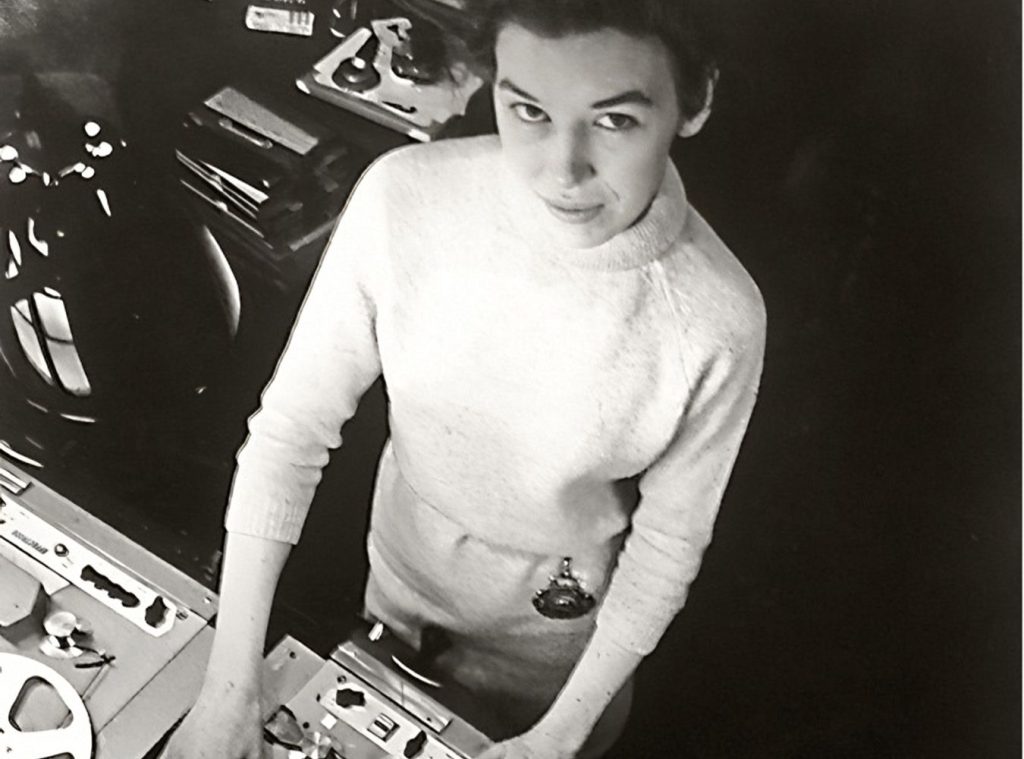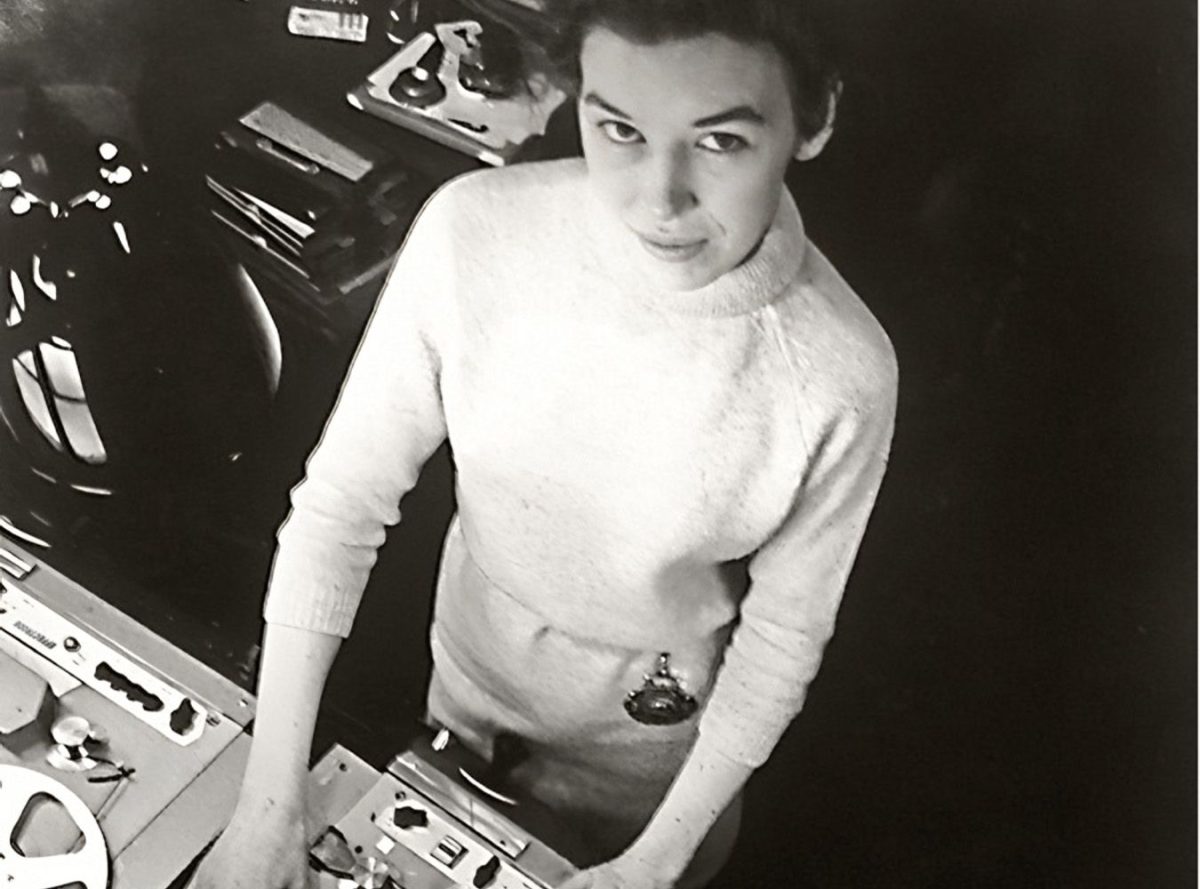by Fraser Hibbitt for the Carl Kruse Arts Blog
The lack of images of Delia Derbyshire belies the importance of her life. Born into a working-class family in Coventry, a city she was forced to evacuate during WWII, she moved to Lancashire while still a child and already showed great intelligence, eventually succeeding in gaining entry into Cambridge University, where, in her words: ‘only one in ten students were female’. Delia, unlike most people who fall into work of some kind after graduating, knew what she wanted: to work with “sound, music, and acoustics”. However, this was the late 1950s when a woman could still be turned down for a position explicitly for being a woman, which is exactly what the Decca Recording Label told her when she tried to apply. Again, unlike the majority, this positive discrimination did not deter her.
After some years of sporadic work as a piano teacher and general assistant in telecommunications (she worked to stay in the orbit of sound), she was hired by the BBC, as a trainee assistant studio manager. In 1962, she was assigned to the BBC’s Radiophonic Workshop. This was it for her; the place she wanted to be. The Radiophonic Workshop had been set up in the late 50s to meet a new kind of demand. The BBC was looking to create soundscapes, peculiar scorings for their new dramatic programme. The Radiophonic Workshop was essentially an experimental space to create sounds that could not be readily proffered from instruments and recordings. Delia was in her element, then: to sculpt sound, to manufacture an atmosphere that would transform radio and TV into their truly otherworldly dimensions.

Photographs of the Radiophonic Workshop studios show a new kind of musical labour. It is to experimental centres like this one that we owe all our software of music engineering, only in 50s everything was completed by hand. The techniques then known were owed to the great exploration into electronic sound with the movement of Musique Concrete as pioneered by the French composer Pierre Schaeffer in the early 40s, although the discussion amongst composers had been in the air for some time, at least ten to fifteen years before Schaeffer. The thoughts were coincident with the gramophone. Composers began to wonder if compositions could be created solely for the gramophone record, and what this would mean for music. In Modernist fashion, experiments were made. Schaeffer saw it as sculpting and manipulating sound; the ‘concrete’ in Musique Concrete refers to bits of sound that could be manipulated by technology. To theorists of that time, the only limitation was the technology they possessed, and Schaeffer and his pupils would go to great lengths to push this limitation. The inevitable end-product is the software we are all familiar with today; the guitar pedals, the synthesizers, the interface for manipulating sound waves.
Sound and, subsequently, music was understood anew through the machinations of the Musique Concrete movement. It would be redundant to say something about ‘the influence of Schaeffer and his pupils’ on all forms of electronic music; Musique Concrete began babbling the vocabulary of that language we are all now so familiar with. However, it must be remembered, Schaeffer and his followers did not think like pop musicians, or sound engineers for TV and radio; of course, the music industry did not have the appeal, the power, the capital, it was to have in the following decades, but even so, Schaeffer and his lot were of the Classical tradition; their outlook appears more philosophical, more mathematical, more like a science, when compared with how those who were influenced by Musique concrete; Frank Zappa, The Beatles, David Bowie, Brian Eno, Kraftwerk… artists who knew how to incorporate principles of Musique Concrete to elevate popular music, or to see wholly how to take its principles and form an artform of their own.
If Delia seems forgotten among these commanding names, it is because she has been. Fortunately, history has a way of revealing more and more with each inspection. Delia worked in Radiophonic Workshop for eleven years, producing painstaking work; over 200 soundscapes for TV and Radio, one of which many will know: The original Doctor Who theme tune. The score, it is true, was not written by her (though she did make additions), but by Ron Grainer. However, through her ‘electronifying’ it was brought to life; Grainer, upon hearing it, commented: “did I write that?” She was denied any royalties or credit despite Grainer’s attempts at giving her co-credit; the BBC preferred, for whatever reason, that members of the Radiophonic Workshop remain anonymous. The Doctor Who theme tune was one of the first themes to be produced solely by the use of electronics; and back then, that process was all done by hand…taping, cutting, and manipulating the film of sound.
Delia understood wholly the Musique Concrete capability, as well as its implications for music; that any object can produce sound and that any sound can be manipulated into pieces of music. She also, more importantly, understood how to use this to create a memorable atmosphere, not just a wall of noise that some ‘avant-garde sound rockers’ are guilty of. She was a sculptor of sound and helped pave the way for electronic music to enter a popular sphere (i.e. The Doctor Who theme tune is a cultural phenomenon that cannot be understated).
In 1975, for reasons that one can only guess, Delia stopped making music, stopped crafting sound. She left a world that had given her little to no credit, though she had succeeded in satisfying her fascination with sound, her own desire to push pass the previous limitations set in music engineering. Delia returned to electronic music in 2001, a final breath, for this was the same year in which she passed. The recognition, through plays, documentaries, and plaques dedicated to this pioneer in electronic music all came posthumously.
=====================
The Carl Kruse Arts Blog homepage is at https://carlkruse.net
Contact: carl AT carlkruse DOT com
Other articles by Fraser include In Memoriam – David Lynch and Art Brut.
